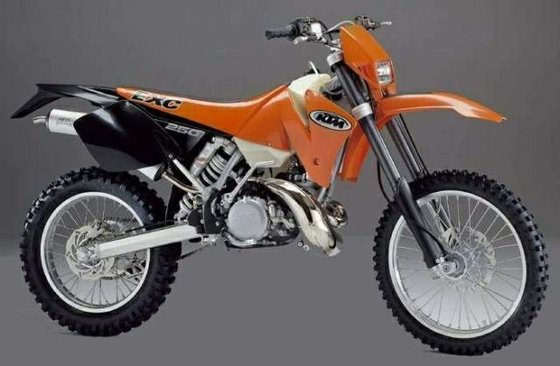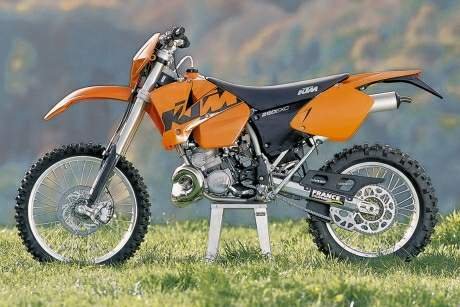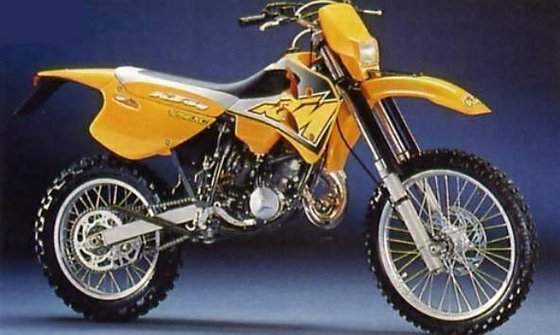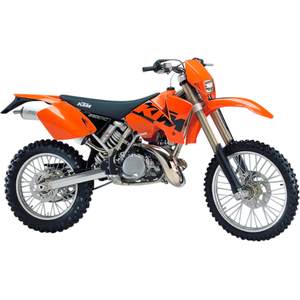KTM 250 EXC (1996–2003): A Timeless Enduro Legend Revisited

Introduction
The KTM 250 EXC isn’t just a motorcycle—it’s a statement. From 1996 to 2003, this Austrian two-stroke dominated the enduro scene with a combination of brute force, agility, and innovation that left competitors scrambling to catch up. Even today, riding a well-maintained 250 EXC feels like strapping into a time machine that teleports you to an era when two-strokes ruled the dirt.
This review isn’t just a nostalgia trip. We’re dissecting what made this bike a benchmark for off-road performance, how it stacks up against rivals of its time, and why it remains a favorite for riders seeking a lightweight, modifiable platform. Whether you’re restoring one or upgrading your trail weapon, the 250 EXC’s DNA is worth understanding.
Engine Performance: The Heart of a Predator
At the core of the KTM 250 EXC lies a liquid-cooled, 249cc two-stroke engine that’s both simple and savage. With a bore and stroke of 67.5 mm x 69.5 mm (2.66" x 2.74"), this single-cylinder powerplant delivers a broad powerband that’s manageable for novices yet explosive enough to satisfy seasoned riders. The Keihin PWK 36mm carburetor—a staple across this generation—provides crisp throttle response, though jetting can be finicky.
Power Delivery
- Low-End Grunt: Unlike peaky MX bikes, the EXC’s powervalve system ensures tractable torque for crawling over roots and rocks.
- Mid-Range Punch: Crack the throttle open, and the bike surges forward with a raspy snarl. Riders often describe the hit as “electric,” but don’t mistake that for tame—it’s more like a controlled lightning strike.
- Top-End Scream: Rev it out, and the engine pulls hard to the limiter, though most trail riders will short-shift to maintain traction.
The 1999 model is particularly revered for its aggressive power curve, outperforming even the 2000 iteration. Later years saw minor tweaks, like the Kokusan digital ignition (replacing the problematic SEM unit), which improved reliability but added a heavier flywheel. Purists argue the added rotational mass dulled the snap, but it enhanced traction in slippery conditions.
Pro Tip: Swap the stock silencer for an aftermarket unit (like the Dyno Port or FMF) to unlock hidden mid-range torque. MOTOPARTS.store offers bolt-on options that won’t deafen your riding buddies.
Chassis and Handling: Precision Meets Durability

KTM’s chrome-moly steel frame strikes a balance between rigidity and flex, offering predictable handling whether you’re carving singletrack or navigating rock gardens. The 48mm WP upside-down forks (rebranded Marzocchi in early models) and WP PDS rear shock provide 280 mm (11") and 320 mm (12.6") of travel, respectively.
On the Trail
- Flickability: At 108–114 kg (238–251 lbs) dry, the 250 EXC feels like a mountain bike with a motor. Flick it into corners, pivot on the pegs, and let the 21” front/18” rear wheel combo chew through ruts.
- Stability: The 63.5° steering head angle and 114 mm (4.5") of trail keep the front end planted at speed, though hard acceleration can induce mild headshake. A steering damper is a wise upgrade for desert racers.
- Ergonomics: The 925 mm (36.4") seat height suits taller riders, but the plank-like perch will have you standing up more often than not. Aftermarket seats are a must for endurance events.
Competition: The Lone Wolf of the Woods
By the late ’90s, Japanese brands had all but abandoned the 250cc enduro segment, leaving KTM unchallenged. Here’s how the EXC compared to its few rivals:
Yamaha WR250 (1998–2001)
- Pros: Bulletproof reliability, plush suspension.
- Cons: Heavier (123 kg vs. KTM’s 108 kg), less aggressive power delivery.
- Verdict: A better choice for beginners, but outgunned in technical terrain.
Honda CR250R (MX Converted for Trails)
- Pros: Legendary MX engine, lighter than the WR.
- Cons: Stiff suspension, no lighting coil, required heavy mods for enduro use.
- Verdict: A project bike—great for tinkerers, frustrating for purists.
Husqvarna WR250 (1996–2003)
- Pros: Italian flair, competitive power.
- Cons: Erratic parts availability, heavier chassis.
- Verdict: A niche alternative, but KTM’s aftermarket support sealed the deal.
The 250 EXC’s hydraulic clutch (introduced in ’97) and bolt-on lighting kit gave it an edge as a race-ready enduro machine. By 2003, it was the only serious player left.
Maintenance: Keeping the Beast Alive

The 250 EXC is forgiving for a two-stroke, but neglect will bite. Here’s your cheat sheet:
Key Service Intervals
- Premix Ratio: Stick to 1:50–1:60 with high-quality synthetic oil. MOTOPARTS.store’s Motorex Cross Power 2T is a crowd favorite.
- Spark Plugs: NGK DCPR8E or iridium DCPR8EIX (gap 0.6 mm). Carry spares—fouling is rare but possible with poor jetting.
- Suspension Fluid: Replace fork oil (SAE 5W, 750 ml per leg) annually. The PDS shock thrives on fresh SAE 30 gear oil.
- Brakes: DOT 4 fluid and sintered pads keep the 260 mm front/220 mm rear discs biting hard.
Common Upgrades
- Jetting Kits: Solve the Keihin carb’s mood swings with a JD Jetting kit (available at MOTOPARTS.store).
- Flywheel Weights: Add/remove mass to tailor power delivery. The ’97–’99 models benefit most.
- Handguards: Protect those levers—this bike belongs in the trees.
Conclusion: Why the 250 EXC Still Matters

The KTM 250 EXC isn’t a relic—it’s a blueprint. Its blend of lightweight aggression, tunable power, and race-bred DNA makes it a perfect base for vintage enduro builds or a trusty steed for weekend warriors. While modern four-strokes have stolen the spotlight, the 250 EXC reminds us that simplicity and soul still matter.
At MOTOPARTS.store, we’re here to keep your EXC alive. From period-correct decals to performance mods, every upgrade is a step toward preserving a legend.
Ride hard. Ride orange.





Specifications sheet
| Engine | |
|---|---|
| Stroke: | Two-stroke |
| Ignition: | Kokusan digital 2K-3 |
| Fuel system: | Keihin PWK 36 S AG Carburettor |
| Lubrication: | Two-stroke oil, mix 1:50–1:60 |
| Displacement: | 249 ccm |
| Configuration: | Single |
| Cooling system: | Liquid cooled |
| Compression ratio: | 6.0:1 (1996–2002), 11.0:1 (2003) |
| Number of cylinders: | 1 |
| Dimensions | |
|---|---|
| Wheelbase: | 1481 mm (58.3 in) |
| Dry weight: | 108 |
| Seat height: | 925 mm (36.4 in) |
| Ground clearance: | 385 mm (15.2 in) |
| Fuel tank capacity: | 9.5 L (2.5 US gal) |
| Drivetrain | |
|---|---|
| Chain type: | 5/8 X 1/4" X-RING |
| Final drive: | chain |
| Gear ratios: | 1st 15:29 / 2nd 18:26 / 3rd 19:22 / 4th 21:20 / 5th 23:18 |
| Transmission: | 5-speed, hydraulically operated wet clutch |
| Rear sprocket: | 50 |
| Front sprocket: | 14 |
| Primary drive ratio: | 25:72 |
| Maintenance | |
|---|---|
| Rear tire: | 140/80-18 |
| Engine oil: | SAE 15W-50 |
| Front tire: | 90/90-21 |
| Brake fluid: | DOT 4 |
| Gearbox oil: | SAE 30 |
| Spark plugs: | NGK DCPR8E or NGK DCPR8EIX |
| Spark plug gap: | 0.6 |
| Coolant capacity: | 1.3 |
| Forks oil capacity: | 1.5 |
| Engine oil capacity: | 1.25 |
| Gearbox oil capacity: | 0.8 |
| Recommended tire pressure (rear): | 2.0 bar (29 psi) |
| Recommended tire pressure (front): | 1.5 bar (22 psi) |
| Chassis and Suspension | |
|---|---|
| Rake: | 26.6° |
| Frame: | Central chrome-moly-steel frame |
| Trail: | 114 mm (4.5 in) |
| Rear brakes: | Single 220 mm disc, floating caliper |
| Front brakes: | Single 260 mm disc, floating caliper |
| Rear suspension: | WP Progressive Damping System (PDS) shock absorber |
| Front suspension: | WP Extreme Ø 50 mm USD fork |
| Rear wheel travel: | 320 mm (12.6 in) |
| Front wheel travel: | 280 mm (11.0 in) |
| Steering head angle: | 63.5° |



















